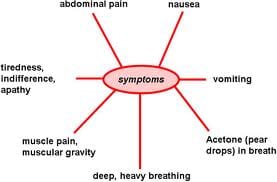Ketoacidosis: A Comprehensive Overview
What is Ketoacidosis?
Ketoacidosis is a serious medical condition that can occur in people with diabetes. It is caused by a buildup of ketones in the blood. Ketones are acids that are produced by the liver when the body does not have enough insulin to use glucose for energy.
Types of Ketoacidosis
There are two main types of ketoacidosis:
- Diabetic ketoacidosis (DKA): This is the most common type of ketoacidosis and occurs in people with diabetes.
- Alcoholic ketoacidosis (AKA): This type of ketoacidosis can occur in people who drink heavily.
Symptoms of Ketoacidosis
The symptoms of ketoacidosis can vary depending on the severity of the condition. However, some common symptoms include:
- High blood sugar
- Frequent urination
- Extreme thirst
- Nausea and vomiting
- Abdominal pain
- Headache
- Fatigue
- Confusion
- Fruity breath odor
Causes of Ketoacidosis
DKA can be caused by a number of factors, including:
- Not taking insulin injections as prescribed
- Illness, such as an infection
- Injury
- Surgery
- Emotional stress
- Pregnancy
- Certain medications
AKA can be caused by:
- Heavy drinking
- Fasting
- Low carbohydrate diets
Diagnosis of Ketoacidosis
Ketoacidosis is diagnosed based on a person’s symptoms and medical history. A doctor will also perform a physical exam and order blood tests to check for high blood sugar and ketones.
Treatment of Ketoacidosis
Ketoacidosis is a medical emergency and requires treatment in a hospital. Treatment typically includes:
- Fluid replacement: People with ketoacidosis are often dehydrated, so they need to receive fluids intravenously (through an IV).
- Electrolyte replacement: Ketoacidosis can also cause electrolyte imbalances, so people with ketoacidosis may need to receive electrolytes such as sodium and potassium intravenously.
- Insulin therapy: Insulin is needed to lower blood sugar levels and stop the production of ketones. Insulin is typically administered intravenously.
Complications of Ketoacidosis
Ketoacidosis can lead to a number of complications, including:
- Hypokalemia: Hypokalemia is a low level of potassium in the blood. Potassium is an important electrolyte that helps regulate muscle and nerve function. Hypokalemia can lead to muscle weakness, cramps, and heart problems.
- Cerebral edema: Cerebral edema is swelling of the brain. Cerebral edema can be caused by a number of factors, including ketoacidosis. Cerebral edema can lead to headache, confusion, seizures, and coma.
- Hyperglycemia: Hyperglycemia is high blood sugar. Hyperglycemia can damage nerves, blood vessels, and organs.
- Ketoacidemia: Ketoacidemia is a buildup of ketones in the blood. Ketoacidemia can lead to a coma.
- Pulmonary edema: Pulmonary edema is fluid buildup in the lungs. Pulmonary edema can make it difficult to breathe.
- Myocardial infarction: Myocardial infarction is a heart attack. A heart attack can be caused by a number of factors, including ketoacidosis. A heart attack can damage the heart muscle and lead to death.
Prevention of Ketoacidosis
The best way to prevent ketoacidosis is to manage diabetes effectively. This includes taking insulin injections as prescribed and monitoring blood sugar levels regularly. It is also important to seek medical attention promptly if you experience any signs or symptoms of ketoacidosis.
Conclusion
Ketoacidosis is a serious medical condition that can occur in people with diabetes. It is caused by a buildup of ketones in the blood. Ketoacidosis is a medical emergency and requires treatment in a hospital. The best way to prevent ketoacidosis is to manage diabetes effectively.
